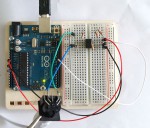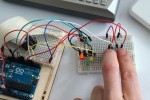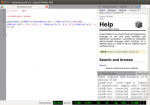Audio production with Muse and Ardour is a 6 part video tutorial showing a complete workflow using FLOSS audio tools. In this tutorial you will learn how to import, clean up and edit a MIDI file using MusE. It then goes on to show how to import the MIDI file into Ardour and setting up instruments to play the song. On to guitar recording and audio editing in Ardour, selecting sounds and editing...
Ardour 3 is a very capable and complex piece of software. A consequence of this is that working with it at times can be a bit daunting, and every possible action cannot always be as intuitive as one might like. In this article, I will go through a number of things I have learned to do in Ardour 3, that hopefully can increase the efficiency of your own work if you’re not already doing them!...
In this tutorial, I’ll go through how to use your Android device to control Ardour through your network. Hi! There’s a great Android application called Ardroid, which is intended to allow your Android device to work as a remote control for Ardour. Ardroid does this by sending OSC messages from your Android device, to you computer running Ardour. Ardour then lets your Android device control it...
In this second installment of our Arduino tutorial series, we will learn to use the Arduino micro-controller as a tool to control electronics by reading MIDI, in this case turning on the Arduino's built in LED when it receives MIDI note on messages. If you haven't already read our first Arduino tutorial on MIDI out , we suggest you at least give it a quick glance. The hardware of this tutorial is...
Note! We have received some concern about connecting "directly" from the Arduino to the MIDI in port of a HW synth. Although we have done this successfully with several different HW setups, note that LMP does not take any responsibility for any catastrophic results of this tutorial. In the next part of this tutorial, " Arduino and MIDI in ", we will introduce the optocoupler. In this tutorial we...
Did you ever wish to play an instrument and interact at the same time with another instrument? As an example: Your audience is listening to your great guitar playing. But you want to give them more than that: With one touch on a piece of fine cutted aluminium foil you can trigger a MIDI control command and add whatever you like to your musical performance: Loops, drums, keyboards... With a little...
Be it for correcting those slightly out-of-tune notes from your singer, or going all the way to a Cher effect, an auto-tune plugin might come in handy. There’s not a lot of those designed for Linux, though choices do exist : Autotalent , a LADSPA plugin by Tom Baran TalentedHack which is a port of the former to the LV2 format with some additional work by Jeremy Salwen VocProc , another LV2 plugin...
In this video series, LMP invites you to mix an entire track together with us. The stems for the track used in this tutorial can be downloaded below. We'll start with importing the stems into Ardour and editing the song material. Next we will arrange the song before doing a basic balanced mix. Finally, we'll throw on some basic mastering effects, and do a few final touches. Download the stems...
A few months ago we published an introduction to the audio programming language SuperCollider here on LMP. With the recent announcement that SuperCollider had reached 3.7.0, we Debian Linux users suddenly find ourselves behind-the-times regarding our SuperCollider packages which are likely to be at 3.6.6 for some time. If you want 3.7.0 now (or any bleeding edge version in the future) you have no...
What is the objective of this tutorial? In this tutorial we're going to make a very simple synthesizer using Pure Data and learn its concepts and workflow along the way. The objective is to get you started with the software in a kind of hands-on approach, doing something relatively useful, relatively quick. If you want in-depth stuff, there are some great sites on the internet. See pd-tutorial...







